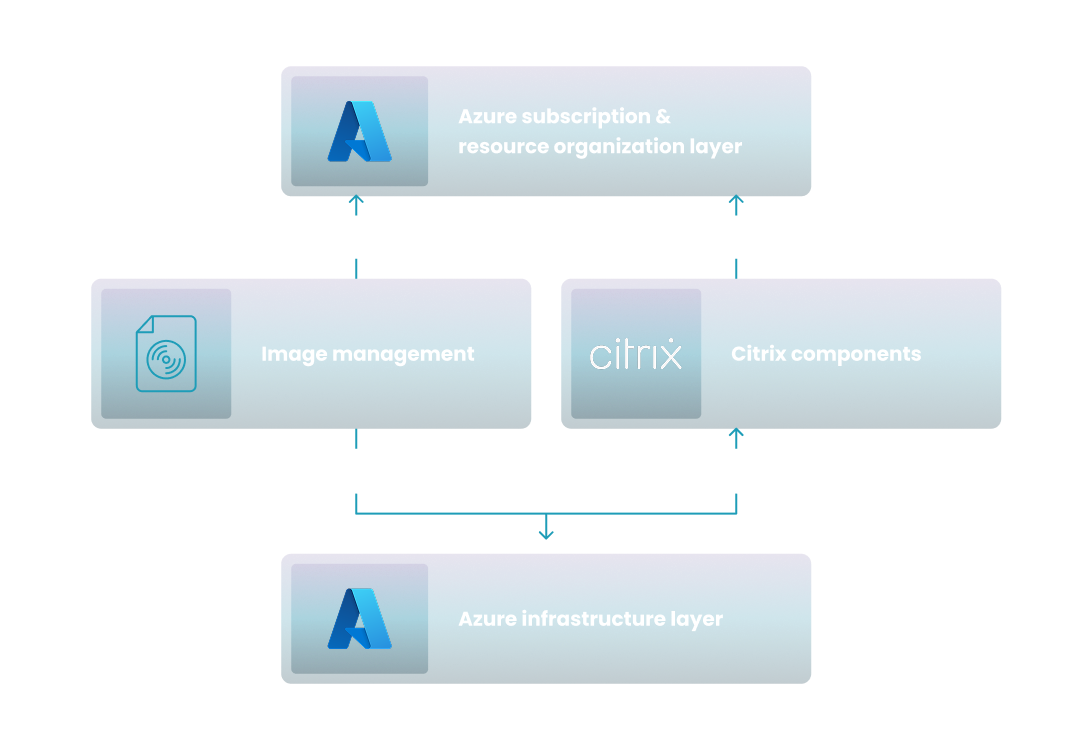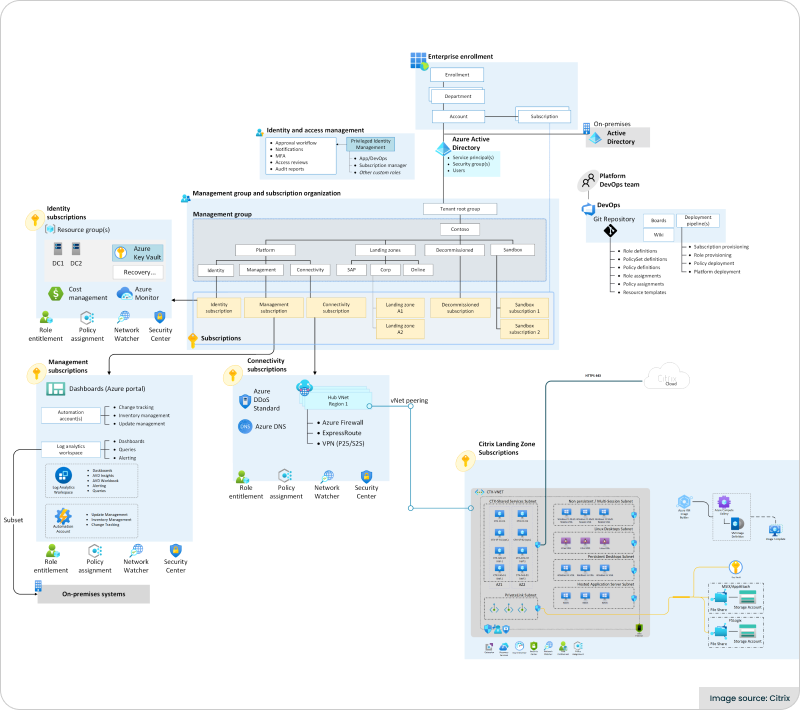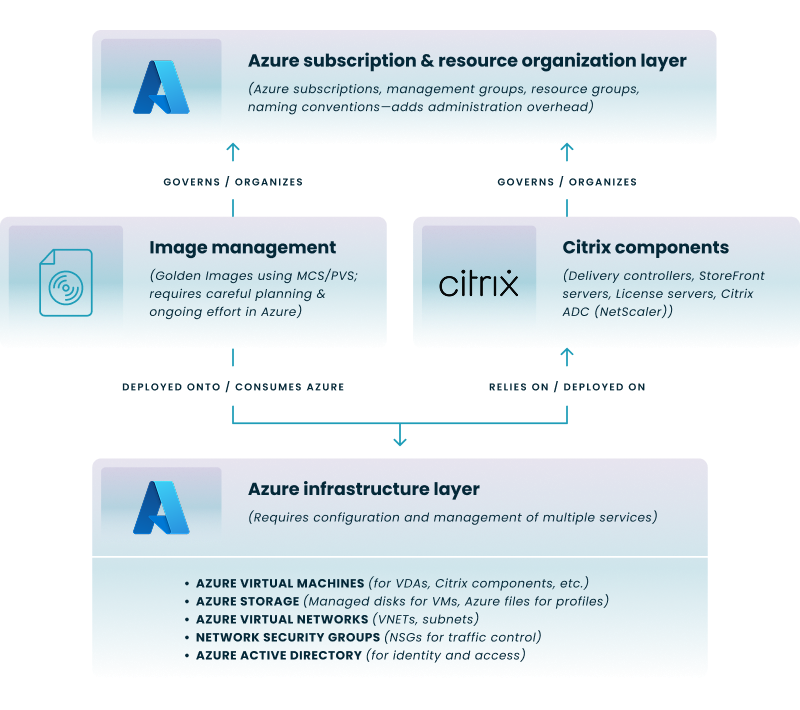Citrix on Azure
This guide reviews Citrix on Microsoft Azure, its growing challenges and costs, and why AVD with Nerdio offers a modern VDI alternative.
NerdioCon 2026: Don’t miss out! Lock in your spot early and save — this is the IT event of the year.
Register Now
This guide reviews Citrix on Microsoft Azure, its growing challenges and costs, and why AVD with Nerdio offers a modern VDI alternative.
Carisa Stinger | June 12, 2025
This guide offers a straightforward look at Citrix on Azure, focusing on the complexities and challenges that are leading many to explore alternatives like Azure Virtual Desktop (AVD) or Windows 365 managed with a solution like Nerdio.
Disclaimer: Content referencing Citrix products is based on public information from the Citrix website and the sources listed in the citations, current as of the last article update. For the latest product details and further inquiries, please consult the official Citrix website.
Traditionally, "Citrix on Azure" meant using Citrix's virtualization tools on Microsoft's Azure cloud platform.1 The core concept was to leverage a virtual desktop infrastructure, which decouples the user's desktop environment—including the operating system, applications, and data—from their physical endpoint device, allowing it to be hosted and managed centrally.
The idea was to combine Citrix's application and desktop delivery features with Azure's infrastructure, often through products like Citrix Virtual Apps and Desktops (CVAD) or its cloud-based counterpart, Citrix DaaS (Desktop as a Service), which offers a subscription-based model to deliver these virtual workspaces.1 The end goal was to deliver Windows desktops and apps to your users on various devices.3
Enterprises look to Citrix on Microsoft Azure for several reasons. Leveraging Azure VDI solutions, such as Azure Virtual Desktop, allows enterprises to deploy and scale virtualized desktops and applications directly within Microsoft's secure and globally available cloud infrastructure, offering a path to modernize end-user computing.
However, the landscape is shifting, and these perceived benefits are now being weighed against significant new challenges.
Azure Virtual Desktop (AVD) is Microsoft's own cloud VDI service, offering features like Windows multi-session capabilities and integration with the Microsoft ecosystem.4 A key component of modern VDI solutions like Azure Virtual Desktop is its support for Windows 11 Enterprise, which offers enhanced security features, multi-session capabilities ideal for virtualized environments, and a familiar, productive user experience.
Citrix solutions were often positioned as an enhancement layer on top of AVD, aiming to add more advanced management, better user experience through HDX, and more granular security.4
While this best-of-both-worlds approach sounded appealing, it also added layers of complexity and cost, which are now under scrutiny.
This guide explains why AVD with Nerdio is the best answer to the Citrix challenge.
Deploying and managing Citrix on Azure involves significant technical depth:

Here we try to simplify it a bit:

Let’s walk through this diagram, starting at the bottom:
These technical demands contribute to the overall operational complexity of a Citrix-Azure environment.
Citrix on Azure has traditionally been used for:
While these use cases remain relevant, the cost and complexity of using Citrix to address them are causing many organizations to seek more efficient alternatives.
Deploying Citrix on Azure involves many decision points:
Each of these considerations highlights the inherent complexity and potential for escalating costs, making simpler, more integrated solutions increasingly attractive.
Citrix DaaS Standard for Azure was presented as a turnkey, Azure-hosted solution to simplify virtual desktop and app delivery, supporting various desktop types and deployment models (non-domain joined, domain-joined).10 It allowed customers to use their own Azure subscriptions, offering some flexibility.10
However, even with DaaS offerings, organizations are still facing broader challenges with the Citrix ecosystem, including pricing and renewal terms, which are prompting a re-evaluation of its overall value.
Many organizations are now facing significant headwinds with their Citrix environments, leading them to actively seek alternatives:
See how you can optimize processes, improve security, increase reliability, and save up to 70% on Microsoft Azure costs.
If the challenges with Citrix resonate with you, Nerdio Manager for Enterprise offers a streamlined path to managing and optimizing Azure Virtual Desktop (AVD). Nerdio also provides expert management for Windows 365, which provides individual users with their own dedicated Cloud PC, offering a complete and personalized Windows experience streamed from the Microsoft cloud with predictable per-user pricing. This makes them compelling alternatives:
| Aspect | Traditional Citrix Environments | AVD with Nerdio Manager |
|---|---|---|
| Management Complexity | High, often manual18 | Low to moderate, automated18 |
| Cost Structure | High upfront, restrictive renewals, potential unexpected increases18 | Consumption-based (Azure), optimized by Nerdio16 |
| Automation | Varies, can be complex to implement | Extensive built-in for AVD18 |
| Image Management | Can be cumbersome16 | Streamlined, automated16 |
| Licensing | Complex, inflexible16 | Simplified with M365, Nerdio PAYG16 |
| Scalability | Possible, but adds to complexity | Native Azure scalability, simplified by Nerdio18 |
Nerdio empowers you to leverage the full potential of Microsoft AVD and Windows 365 without the traditional VDI complexities and cost burdens associated with solutions like Citrix.
See this demo to discover how you can simplify operations, enhance security, and lower the total Azure cost of your entire Windows 365 or AVD environment with Nerdio Manager.
See how you can optimize processes, improve security, increase reliability, and save up to 70% on Microsoft Azure costs.
If you're facing challenges with Citrix pricing, renewals, or complexity, it's time to evaluate a new path forward:
The current VDI landscape is evolving rapidly. Don't let legacy complexities and unfavorable vendor terms hold your organization back. Exploring modern solutions like Azure Virtual Desktop, managed and optimized by Nerdio, can offer a more agile, cost-effective, and future-proof approach to end-user computing.
This guide explains why AVD with Nerdio is the best answer to the Citrix challenge.

On-demand webinar



Carisa Stinger
Head of Product Marketing
Carisa Stringer is the Head of Product Marketing at Nerdio, where she leads the strategy and execution of go-to-market plans for the company’s enterprise and managed service provider solutions. She joined Nerdio in 2025, bringing 20+ years of experience in end user computing, desktops-as-a-service, and Microsoft technologies. Prior to her current role, Carisa held key product marketing positions at Citrix and Anthology, where she contributed to innovative go-to-market initiatives. Her career reflects a strong track record in driving growth and adoption in the enterprise technology sector. Carisa holds a Bachelor of Science in Industrial Engineering from the Georgia Institute of Technology.